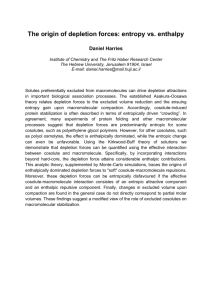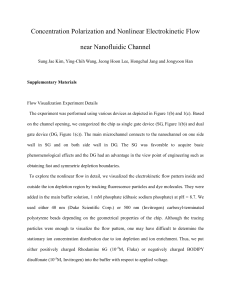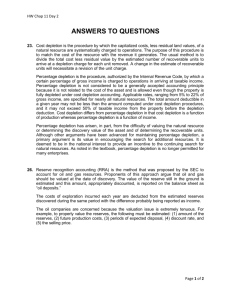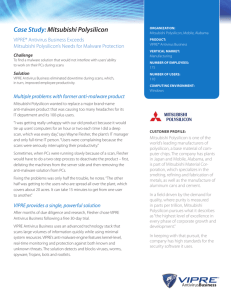Depletion Code System
advertisement
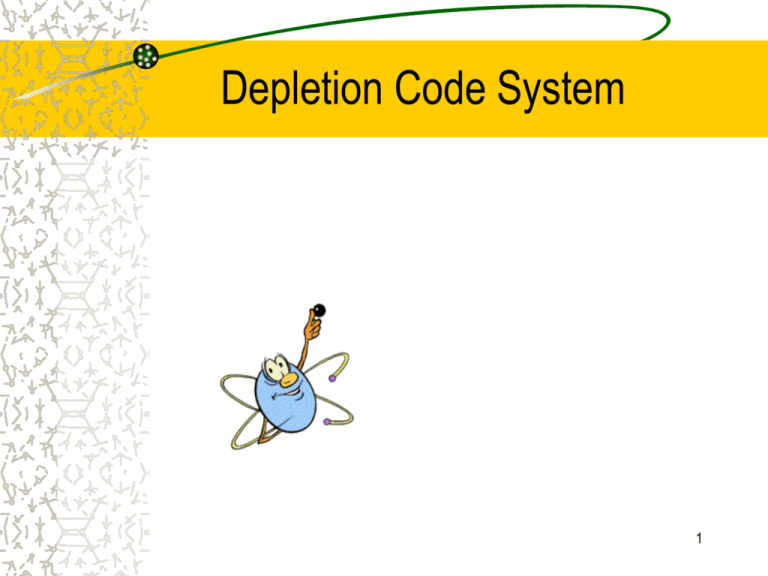
Depletion Code System 1 Depletion Code System Yunlin Xu T.K. Kim T.J. Downar School of Nuclear Engineering Purdue University March 28, 2001 2 Content Motivation What is Depletion? Depletion code system Verification Further improvements 3 Motivation Why do we need depletion code system? Basic tool for Nuclear Reactor fuel cycle analysis NERI/DOE projects at Purdue SBWR HCBWR Nuclear Power Reactor Analysis – Economics – Safety (throughout core life) 4 What is Depletion? Nuclide density change in nuclear reactor core when operated at power Related changes Cross Section Nuclide density (Heavy metal, Cross Section feedback Fission products) Decay Heat Reactivity economic safety Depletion code system must solve coupled nuclide/neutron and temperature/fluid field equations 5 Cm246 Heavy Metal Chains Cm245 Pu243 Am244 Cm244 Am243 Cm243 m Pu242 Am242 Am242 Cm242 Pu241 Np240 Pu240 U239 Np239 Pu239 U238 Np238 Pu238 U237 U236 α Am241 α Np237 Np236 Pu236 U235 α Pa234 Th233 U234 (n,3n) Pa233 U233 Th232 Pa232 U232 Th231 Pa231 U231 (n,3n) Th230 α (n,3n) Arrow up Arrow down Arrow left Arrow right :neutron capture :(n,2n) reaction :electron capture : decay or decay for Am242m 6 Equations for Depletion Nuclide depletion equation (Bateman) dN A (t ) ( Aa A ) N A (t ) C N c (t ) B N B (t ) dt Absorb netron B β β A n,γ C Neutron Transport Equation (Boltzmann) 1 1 (r , E , , t ) t (r , E ) (r , E , , t ) S f (r , E , t ) v t 4 s (r , E ' E , ' ) (r , E ' , ' , t )dE ' d' ' E ' 7 Micro vs Macroscopic Depletion N i i Microscopic Lattice code provide σ Solve for Nuclide Field from the Bateman equation Σ change depend on Ni and σ i Macroscopic Lattice code provide Σ N/A (Nuclide density and micro changes are combined) Σ change depend on Burnup Complicated Easy to implement Smaller history effect Larger history effect 8 Basic Depletion code system Lattice Code (HELIOS) Neutron Flux Solver (PARCS) Σ Cross Section Library (PMAX) T/H code (RELAP /TRAC) Φ Depletion Code (DEPLETOR) 9 HELIOS and PMAX HELIOS is a comercial (Studsvik Scandpower) lattice physics code for solving Boltzmann equation with fine energy group, heterogeneous, twoDimensional models of the fuel lattice Gadolinium pin BP1 BP2 HELIOS uses consistent fuel assembly homogenization and energy group collapsing methods to produce few group cross sections at all fuel assembly conditions throughout the burnup cycle. PMAX tabulates the XS’s of the base state and the derivatives or difference of XS of the branches The octant of fuel assembly 10 Base state and Branches Base state 0GWD/T Branches Fuel temp. mod temp. Mod. den. Soluble B. Control Tf1, Tf2… Tm1, Tm2… Dm1, Dm2… ppm1, … rod … Fuel temp. mod temp. Mod. den. Soluble B. Control Tf1, Tf2… Tm1, Tm2… Dm1, Dm2… ppm1, … rod … 1GWD/T 2GWD/T 3GWD/T 4GWD/T 5GWD/T 11 Reactor Core Configuration Characteristics of Configuration Heterogeneous in Radial Direction - Fuel Assemblies - Fissionable Absorbers - Control Banks - Reflectors •Homogeneous / Heterogeneous in Axial Direction 12 PARCS Purdue Advanced Reactor Core Simulator A Multidimensional Multigroup Reactor Kinetics Code Based on the Nonlinear Nodal Method Under NRC Contract Thomas J. Downar Han Gyu Joo Douglas A. Barber Matt Miller 13 PARCS Validation Pressurized Water Reactor: – Reactivity Initiated Transients (CEA, etc.) – OECD TMI Main Steam Line Break (PARCS coupled to RELAP5 and TRAC-M) Boiling Water Reactor – OECD Peach Bottom Turbine Trip Benchmark – OECD Ringhalls Stability Benchmark (Ongoing) 14 PARCS The Cross Section representation used in PARCS 1 2 ( ppm, Tf , Tm, D) ppm Tf Tm D (D) 2 2 ppm Tm D 2 D Tf r Where Σr: XS at reference state ppm: soluble boron concentration (ppm) Tf: fuel temperature (k) Tm: moderator temperature (k) D: moderator density (g/cc) 15 Coupling Coupling of of PARCS PARCS to to TRAC-M/RELAP5 DEPLETOR Thermal Depletor Hydraulics Input Input Tf Tfcl Tfsf v l P B Tm Neutronics Input Depl. Side T/H Side Interface Input T/H P2DIR Data Map (A) (AB) Q fp Q ac Memory Structure (A) Tf v Tm Thermal DEPLETOR Hydraulics Qf Neut. Side Interface Input General Interface Neut. Data Map (AB) (B) Memory Structure (AB) Tfcl l Tfsf P B Neutronics Qf Q Qfp ac Memory Structure (B) 16 Depletion code system based on PARCS In order to minimize the changes to PARCS, A separate code DEPLETOR was developed The general interface used to couple TH (RELAP5) and PARCS was used to coupled DEPLETOR to PARCS The message transfer between PARCS and DEPLETOR is performed using the standard message passing interface software PVM. P2DIR, a module to communicate with DEPLETOR, was created in PARCS (only 5 entry points in PARCS) 17 Algorithm for Depletion code system PARCS DEPLETOR Read inputs Read inputs Exchange ID Initialize PVM Initialize PVM Nodalization Calculate XS Receive XS XS & Derivatives Send XS Neutron Flux Calc Send Fluxes Burnup Clac Flux & XS Receive Fluxes EOC EOC END END 18 Coupling PARCS/DEPLETOR to TH RELAP/TRAC PARCS PREPROC DEPLETOR SCANINPUT depl INPUTD READINP CHANGEDIM y depl CHANGECOMI n P2DIR(1) D2NIR(1) P2DIR(2) D2NIR(2) INITIAL XSB INIT R(T)DMR(1) PDMR(1) PDMR(2) y extth n y depl n P2DIR(4) P2DIR(2) R(T)DMR(2) PDMR(2) R(T)DMR(3) PDMR(3) done y End Thconv y D2NIR(2) XSB SSEIG y End n D2NIR(4) n EOC DEPLETION n n n depl y P2DIR(3) D2NIR(3) EOC y End 19 Cross Section Model used in Depletor Interpolating XS for a Specified burnup Using a Tabular XS Set ( Bi ) ( Bn ) Bn1 Bi B Bn ( Bn1 ) i Bn1 Bn Bn1 Bn Bn1 Bi Bn Calculating the Burnup Distribution. B(i ) Bc P(i ) Pc / G (i ) Gc ΔB(i): burnup increment of ith region ΔBc: Core average burnup increment G(i): the heavy metal loading in ith region Gc: total heavy metal loading in the core Pc: Total power in core. P(i): Power in ith region P(i ) V ( j )( [(ig , j ) f (ig , j )]) ji ig 20 Cross Section Model used in Depletor Calculating XS and Derivatives at Reference States 1 2 ( x ) x (x) 2 2 x 2 x r No Branch State Case 1 2 0 x 2 x 2 r 0 ( x0 ) One Branch State Case r 0 ( xr x0 )d1 d1 x 1 2 0 2 x 2 Two Branch States Case r 0 ( x0 xr ) d1 ( x2 xr ) d 2 ( x1 xr ) x2 x1 d1 ( x2 x0 2 xr ) d 2 ( x1 x0 2 xr ) x x2 x1 1 2 d 2 d1 2 x 2 x2 x1 21 Verification Problem 1: Single Assembly with reflective B.C. Comparison with HELIOS PARCS/HELIOS PARCS/HELIOScomparison comparison with 500ppm 1.10 1.10 Gadolinium HELIOS HELIOS PARCS PARCS pin 1.05 1.05 Kinf Kinf BP1 1.00 1.00 0.95 0.95 BP2 0.90 0.90 00 10 10 20 20 30 40 30 40 Burnup(GWD/T) 50 60 Maximum Difference 2×10-5 22 50 60 Burnup(GWD/T) The octant of fuel assembly Verification Problem 2 Checkerboard small core with vaccum B.C. Compared with MASTER (KEARI) PARCS/MASTER Comparison 1.20 Vacuum Vacuum 1.18 R3 R3 R3 R3 R3 R3 A A A R3 R2 MASTER PARCS 30 R2 21.607 R2 1.16 C A R3 R3 A A A R3 Keff A R3 R3 R3 R3 R3 1.10 1.08 200.0 R3 1.12 Vacuum Vacuum 1.14 R3 R3 1.06 1.04 Vacuum 1.02 1.00 0 2 4 6 8 10 12 14 16 Burnup(GWD/T) R2 R2 R2 Maximum Difference 0.3% Vacuum 23 BWR model Mapping between Neutronic and T/H model SINK 401 Upper Plenum: 400 301 A B 302 303 B A 201 101 Neutronic model TANK 099 202 102 203 103 Lower Plenum: 100 Plenum to Plenum T/H model 24 Comparison between RELAP and VIPRE RELAP and TRAC are transient codes and do not solve the steady-state thermal-hydraulics equations We therefore examined another T/H code, VIPRE (EPRI), which has a steady state option There are three models in VIPRE: HEM, Drift Flux Model, and Two Fluid Model Drift Flux Model was used for preliminary comparison RELAP VIPRE DIFFERENCE TH steps per depletion step 1123 75 -93.3% keff 1.0816502 1.0816311 -1.9pcm fxy 1.0897 1.0878 -0.17% fz 1.8066 1.8200 0.74% Exit void Fraction Chan-1 0.6572 0.6578 0.06% Chan-2 0.7150 0.7172 0.22% Maximum fuel Temperature (K) Chan-1 2144.4 2153.9 9.5 Chan-2 1847.3 1844.8 -2.5 25 Comparison between RELAP and VIPRE 1 2 0.9 1.8 1.6 0.7 1.4 0.6 relative power void fraction Active Core 0.8 0.5 RELAP 0.4 Vipre Relap 1.2 1 0.8 0.3 VIPRE 0.6 0.2 0.4 0.1 0.2 0 0 1 2 3 4 5 6 7 8 9 10 11 12 13 14 15 16 17 18 19 20 0 0 axial node 1 2 3 4 5 6 7 8 9 10 11 12 13 14 15 16 17 18 19 20 564 2200 562 2000 RELAP VIPRE 560 558 556 554 Fuel centerline temperature (K) Liquid Temperature (K) axial node 1800 RELAP VIPRE 1600 1400 1200 1000 552 800 550 0 1 2 3 4 5 6 7 8 9 10 11 12 13 14 15 16 17 18 19 20 axial node 600 0 1 2 3 4 5 6 7 8 9 10 11 12 13 14 15 16 17 18 19 20 axial node 26 Comparison between RELAP and VIPRE There is generally good agreement between RELAP and VIPRE The only visible difference is the fluid temperature which may be due to the sub-cooled void model. VIPRE provides LEVY and EPRI models (The EPRI model is used in this comparison) 27 Further improvements VIPRE Two Fluid Model History effects in Macroscopic X-sections Predictor-corrector Time integration method Microscopic depletion? 28 Thank You ! 29


